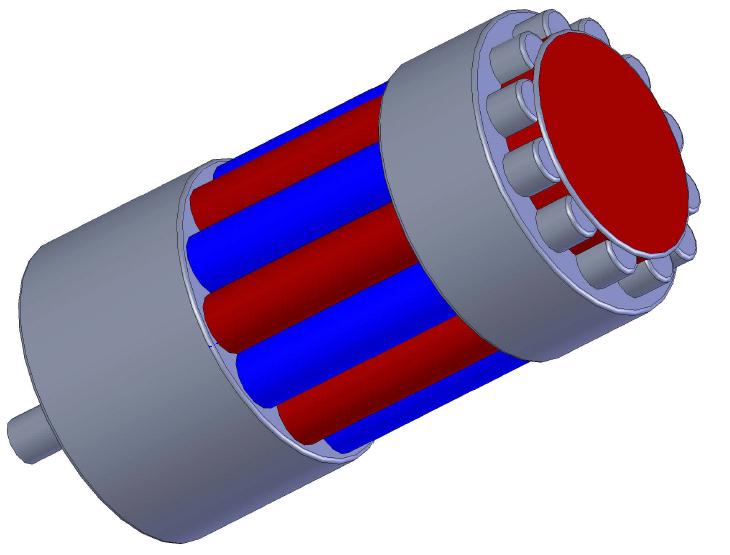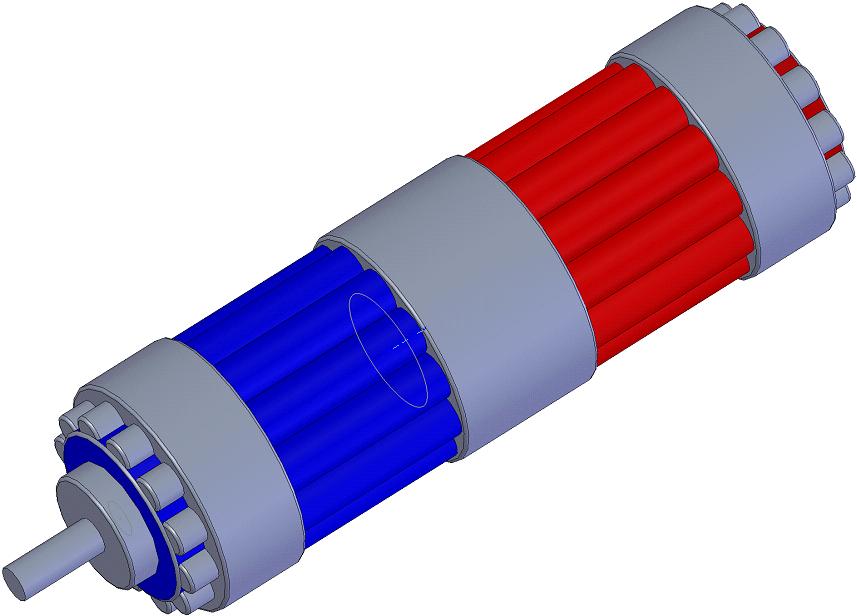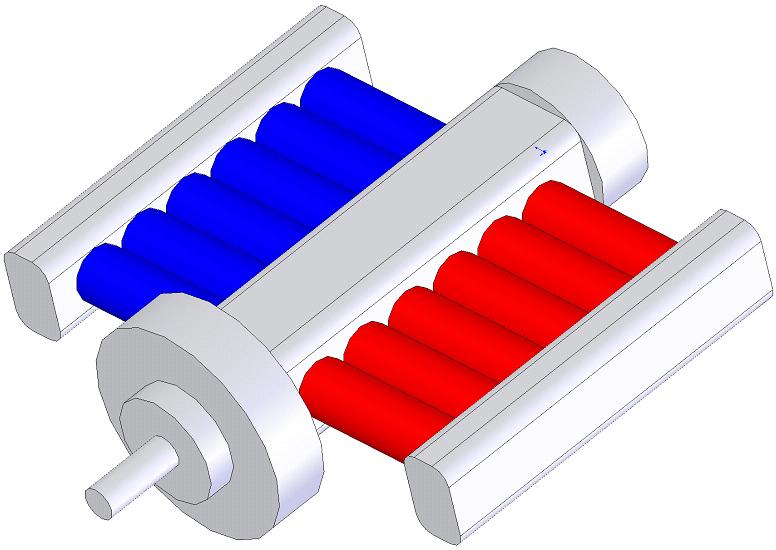|
ENGINE WITH COMBUSTION
Clean engines for land and sea
transport has low noise, low toxicity and the ability to exhaust the
various fuels.Comparable to the engine size
and weight. All of these options provide an opportunity to challenge
the internal combustion engine.The source of thermal energy
you can use any heat source: solar energy, biofuels, nuclear energy,
electricity and so on.
The challenge underlying the solution is to create a heat
engine with expanded functionality.Namely, first, creating the possibility of
operating the engine in the heat pump, which will in return the
braking energy and store it in a heat accumulator for later use.
Secondly, creating the possibility of starting the engine without a
forced way, which will abandon the starter device and devices turn
off the engine with the clutch mechanism of the executive, as well
as from the engine to operate in Idle Mode.Third, creating the possibility
of rotation of the motor shaft in any direction, which will abandon
the device changes direction of rotation.Together, the rejection of
part of the transmission equipment will improve efficiency and
reduce material devices serviced engine.
Structurally, the engine has four extensive
and four compression cylinder.The cylinders are alternately and in
parallel around the axis of the working shaft engine.
The mechanism of
conversion of reciprocating motion is made in the form of oblique
washers, as the drive axial-piston pump.Combustion occurs
in the heat exchange chamber.
To heat to the working body through the heat transfer
tubes.When
compressing the working medium is carried out the withdrawal of heat
through heat transfer tubing and cooling the working medium in the
cooler (radiators).Number of gas (they can
be air), a prisoner in a working volume of the engine, continuously
and irremovable. Working the body is under great pressure, the order
of 40-200 atm.
Appearance engine modifications:




The engine is roughly the same size and
weight as an ordinary gasoline engine.
By the features of the proposed engine are:
High KP e. Ability to obtain a high-KP
village and, consequently, a large economy is an important
feature of the engine.
This is due to the full use of differential temperature and
pressure in the cycle.But to
realize these opportunities need to overcome significant design and
technological difficulties, and difficulties in the selection of
materials for the manufacture of engine parts.
Various heat sources. The external supply of heat used in
the engine, allow the use of different heat sources, without any
significant change the engine design.Almost all
fossil fuels from solid to gas can be directly used in the
engine.
To do this, equip the engine combustion chamber with a
regenerative heat exchanger for preheating the air charge heat of
exhaust gases.
In cities with heavy traffic for use in
vehicles has great prospects for the engine to heat the
battery.
The advantage of the engine is
also in that it can be used in a variety of fuels, but also provides
an opportunity to apply various types of heat sources.
This means
that the engine does not depend on the availability of the
atmosphere.It could equally well work in a
confined space, as on submarines, and on satellites.
The impact
on the environment (toxicity, noise, vibration).
Obviously, the toxicity of engine (in
the conventional sense), it is possible to speak only when using the
heat of combustion of fuel.
Sources of toxic substances are
the products of combustion and evaporation of it from the feed
system.The engine works on the closed-loop, so it
is not the crankcase and the combustion products resulting from the
crankcase does not release toxic substances.
Evaporation into the atmosphere in the engine is
much less than that of gasoline internal combustion engines, as well
as the fuel system of closed type.Virtually the only
source of toxic substances - products of combustion out of the
atmosphere from the combustion chamber.
The main toxic
substances contained in products of combustion of such fuels are
carbon monoxide CO, unburned hydrocarbons C x H
y, NO x, nitrogen oxides, aldehydes, soot,
sulfur oxides (using sulfur fuels), lead (for leaded
petrol).
Estimate the toxicity of
the engine on the allocation of carbon monoxide, hydrocarbons,
nitrogen oxides, as well as opacity. the allocation of
available or imposed statutory limitations.Toxic products
of incomplete combustion (CO and C x H y) are
the result of lack of oxygen during the combustion (at small general
or local rates of excess air).
Soot in the
exhaust gases is shown in those cases when the thermal decomposition
of hydrocarbons (cracking) at high temperatures and lack of
oxygen.Cameras combustion engine similar to the
combustion chamber of gas turbine and steam engines.
The process of burning them is
stationary.
In such circumstances, can provide enough high quality of
mixture.The air entering the combustion
chamber, is heated in a special heater exhaust gases.
Obviously, the
selection of toxic substances in exhaust gases into the engine
depends on the coefficient of excess air during combustion and the
temperature of inlet air into the combustion chamber.
With the increase of the coefficient of excess air
during combustion decreases the concentration of CO, C x
H y and NO x.Consideration of
the mass of the toxic components released during the combustion of
unit quantity of fuel, leads to the same conclusion.
It is important to
note a very small concentration of CO, C x H
in. The concentration of NO x decreases with
increasing excess air ratio due to the significant impact of
reducing the temperature compared with the impact of increasing the
number of free oxygen in the combustion products.Because the coefficient
of excess air increases the efficiency of the engine a few drops,
then the rational value of the coefficient of excess air during
combustion is about 1,5-1,8.
With the increase of air temperature entering the combustion
chamber, at a constant ratio of excess air content of products of
incomplete combustion (CO and C x H y) is
decreasing and the concentration of NO x
increases.Efficiency of the engine also increases with
increasing air temperature at the inlet to the combustion
chamber.Reducing the
concentration of CO and C x H a due to
improved conditions of combustion in a hot air.Increased
concentrations of NO x caused by the increase in the
maximum temperature of combustion at a constant ratio of excess
air.
Inlet air temperature in the combustion chamber in the engine
reaches 600-800 В° C.
It should be noted that the engine
exhaust gases have no smell and does not contain carbon
black.
The above material shows that the greatest
impact on emissions of nitrogen oxides have a motor. The allocation
might be reduced by exposure to conditions in the combustion chamber
(the maximum decrease in temperature and oxygen
concentration).To lower the
temperature in the combustion zone by selecting the appropriate
parameters of the combustion chamber or use exhaust gas
recirculation (as in internal combustion engines).
Increasing the number
of perepuskaemyh exhaust more than 33% of the number of
incoming fresh air is not feasible, as this significantly increases
the concentration of CO and NO x concentration decreases
less significantly.
To assess the level of
toxicity in the table below shows the engine unit of toxic
substances in the engine, the diesel engine, gas turbine and
the gasoline engine.
|
Engine type |
Toxic constituents in
mg / (bhp c) |
|
NO x |
CO |
C x H
in |
| Engine DVPT |
0,1-0,2 |
0,05-0,2 |
0,0015-0,009 |
| Gas turbines (with
regenerator) |
0,7-2,0 |
2,0-3,6 |
0,0120-0,072 |
|
Diesel |
0,4-2,0 |
0.2-5,0 |
0,6-12 |
| Petrol engines |
0,6-2,0 |
40-100 |
15-120 |
From the
table it follows that even without the adoption of special measures,
the toxicity of engine exhaust gas is significantly lower toxicity
of other types of heat engines.
Low noise and vibration.
The main sources of noise in internal combustion engines are turbo,
the combustion process, the processes of intake and exhaust
timing mechanism, crank, connecting rods and the support mechanisms
(due to the presence of gaps in the toothing, occasionally
overlapping gaps in the joints and movable etc.).Noise generation mechanisms in the auxiliary
engines of the internal and external combustion can take the same,
other sources of noise in the engine are not available, so the noise
from the engine is running, much less than the internal combustion
engine.External combustion in the engine occurs
continuously and does not have an explosive character, which, when
burned, and release almost no noise is generated.
In addition, the pressure in
the cylinders of the engine varies smoothly on almost sinusoidal
law.The noise level of the engine at an average
of 20-30 dB lower than the diesel engine is the same
power.
Consumption of lubricating oil. In
internal combustion engines hit the oil in the cylinder, on the
one hand, leads to the burning of oil, on the other hand, due to
its aging contact with hot gases and engine parts.
The proposed engine oil practically
can not get into the working cavity and, moreover, did not come with
any hot gases or the hot parts, so not happening either burnout or
osmoleniya oil.As a result, the engine is no longer necessary
to periodically adding oil.In principle,
the engine can develop throughout motoresursa initially filled with
oil (if time does not change its properties under the influence of
the environment), which is cleared only on the abrasive
particles.For the heavy-and medium-power is an
important economic advantage (cost of lubricating oil is 10 times
higher than the cost of fuel).For low-power engines that significantly
reduces labor services.
Release of oil in the
engine working conditions is extremely undesirable and extremely
damaging phenomenon, as well as changing the properties of gas and,
consequently, the effective efficiency of the
engine.Therefore, in the engine are not lubricate
the piston rings, and lubricant is required only to lubricate the
drive mechanism and support units.As the piston seals in the engine used
continuous ring of fluoroplastic or composite materials based on the
latter.
Reliable and fast
start-up of the engine at low temperatures. The proposed engine
with high pressure of gas in the inner cavities and sufficiently
high temperature heater tubes, easy starts at any temperature
environment. His start-up depends entirely on the reliability, which
may ignite the fuel in the chamber combustion.Spark
plugs, which merged with the nozzle in a single whole, virtually
guarantees the start-up of the engine under all environmental
parameters.
Tolerance to dust the surrounding area. Because the
proposed engine - external combustion engine, the dust in the
air charge entering the combustion chamber from the surrounding
space, did not reach the crankcase and cylinders (in the engine
crankcase ventilation is not required).As a result, the engine no
additional abrasion of moving parts of drive mechanism.
In addition, because of the
low-speed air charge and exhaust gas in the regenerative heat
exchanger of a combustion chamber (heater air charge) and its
raspylivayuschem device, corrosion of these components is
negligible.
Dealing with short-term overloads. Motoresurs engine speed
is determined by the onset of creep limit of the material details of
the heater operating at high temperature.
With increasing pressure of gas in the inner cavities of the
engine speed limit creep increases.Nevertheless, short-term overload
associated with increased pressure of gas in the inner cavities,
slightly reduce the longevity of the engine, as well as details of
the heater temperature stays constant.
In general, any engine can be
guaranteed to withstand a short-term 50-80% integrated overload
without significant reduction in durability.
Heat in the cooling medium. Due to the availability of the
engine closed-loop system circulating the working medium heat almost
exclusively through the cooler, the heat should be possible
at lower temperatures.
Therefore the quantity of heat spent in the cooling water in the
engine at approximately 2 times higher than in internal combustion
engines, where the same effective performance. Therefore,
the size of the radiator cooling system of engines in vehicles
produced more than internal combustion engines of the same
destination .
In the
ship's engines, this feature is not a serious
shortcoming.
BASIC PARAMETERS Engines of 1500
cm 3
| NAME OF INDICATOR |
Ed.
amend. |
INDICATOR |
| Number of cylinders |
sh t |
8 |
|
Power |
l. c. |
124 |
| Number of turns |
of b / min |
3000 |
| Efficiency |
% |
52 |
| The coefficient of the progress of the
piston |
|
2.6 |
| The average gas pressure in the
cycle |
by HS / cm 2
|
32.0 |
| Displacement Cylinder |
with 3 m
|
1500 |
| The diameter of the engine
|
with m |
21.5 |
| The length of the engine |
with m |
64.5 |
| The content of CO |
g / km |
0,05-0,2 |
| Contents of C
x H in |
g / cm |
0,0015-0,009 |
| The contents of NO
x |
g / km |
0,1-0,2 |
| Weight of engine |
Ms. |
95 |
| Operating body |
|
Helium |
| Type |
|
Slant Pack |
| Location of cylinders |
|
Drum |
| Source of heat |
|
The
heat battery and mnogotoplivnaya the combustion
chamber |
| Assignment Engine |
|
The car and ship
|
Appearance PILOT MODEL
ENGINE

BASIC PARAMETERS OF
SETTLEMENT PILOT MODEL ENGINE
| NAME OF
INDICATOR |
Ed.
amend. |
INDICATOR |
| Number of cylinders |
pc. |
2 |
|
Power |
kW / hp. |
3.5/4.7 |
| Number of turns |
rpm |
1000 |
|
Efficiency |
% |
61 |
| The coefficient of the progress of the
piston |
|
4 |
| The maximum gas pressure
in the cycle |
atm. |
226 |
| Displacement Cylinder |
cm 3
|
100 |
| The diameter of the engine
|
mm |
89 |
| The length of the engine |
mm |
453 |
| The content of CO |
g / km |
0.05-0.2 |
| Contents of C
x H in |
g / cm |
0.0015-0.009 |
| The contents of NO
x |
g / km |
0.1-0.2 |
| Weight of engine |
kg |
7 |
| Operating body |
|
Carbon dioxide |
| Source of heat |
|
The
heat battery and mnogotoplivnaya the combustion
chamber |
"The engine with
the external leads heat.The patent number
2105156 dated June 23, 1995. RF.
"The engine with
the external leads heat.Patent number
2149275, dated 31 May 1999. RF.
|